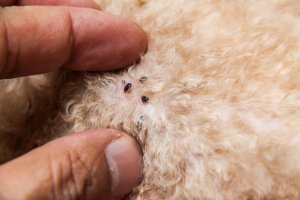With the fall season comes cooler weather, changing leaves, and unfortunately, fleas and ticks. Preventing your pets from picking up these pests requires a year-round regimen, but the upcoming fall season is an active time for these parasites.
How Do Dogs and Cats Pick Up Fleas and Ticks?
It is fairly easy for cats and dogs to pick up parasites like fleas and ticks. In many cases, they pick them up by passing by trees and shrubs, or by laying outside in the grass. They can also catch them from other cats and dogs at the dog park, groomers, or in kennels.
Dangers of Fleas and Ticks
While fleas are known to cause itchiness, they can also lead to:
- Hair loss
- Allergy dermatitis
- Anemia (in extreme cases)
Ticks, on the other hand, don’t cause a lot of obvious discomfort such as itching, but their bites can lead to other severe symptoms such as:
- Anemia
- Paralysis
- Serious Infections (such as Lyme disease)
These risks are a threat to your pet’s health, so it is vital to have a regimen for preventing your pet from catching fleas or ticks year-round, especially during the peak seasons.
 Peak Flea and Tick Season
Peak Flea and Tick Season
In Ohio, March-December is when ticks and fleas are most active due to the warmer, wet weather. The cooler, drier winter weather will offer your pets some relief, but it is crucial to treat against fleas throughout all seasons. Summer is one of the most active times for fleas and ticks, with some of the worst season being fall, in September, October, and November.
Research has shown that the number of fleas on cats and dogs is 70% in the fall when compared to the spring season. This increase is primarily caused by animals getting their thicker winter coats in paired with the warm and wet weather.
Protecting Your Pet from Fleas and Ticks
Most pets will encounter fleas or ticks in their lifetime unless they are strictly indoor animals. The best way to prevent your pet from becoming infected with these parasites is to maintain a regimen of regular flea and tick treatment. Types of flea and tick treatment include:
- Pills
- Chewable tablets
- Topical treatments
These year-round treatments are the best way to keep the fleas and ticks at bay. Flea treatments work by using pesticides to kill the adult fleas on your dog or cat. These pesticides are safe for use around people and pets according to the Environmental Protection Agency. Many of these medications also include insect-growth regulators which prevent fleas from reproducing and laying eggs.
In addition to medications, you can also apply treatments to your property to keep these parasites away. You can spray your yard and garden with a variety of outdoor spray solutions. It is also recommended that your keep garbage sealed and shut to keep flea and tick-infested feral animals from coming onto your property and infesting it.
Schedule Your Pet’s Exam Today!
At the Animal Medical Center of Streetsboro, we are dedicated to helping your pet lead a long and healthy life. If you suspect your pet may be infested with fleas or ticks, schedule an exam today. Our highly-trained veterinarian staff will evaluate your pet’s condition and prescribe the best products to help eliminate the fleas or ticks.
Contact us today to learn more about tick and flea prevention.

